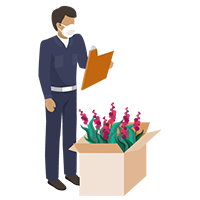We have been improving this page and would like to hear from you.
Share your feedback at the end of the page. Answer the question ‘Was this page helpful?’. You can also add comments to your response.
Follow these steps to help you import fresh cut flowers and foliage.
This guide will help you meet biosecurity requirements for your goods. It also details how we manage risks of pests and diseases to achieve Australia’s Appropriate Level of Protection.
Only flowers that we verify are free from pests and diseases can enter Australia.
Fees and charges may apply to some steps.
Before you import
You must know and be able to meet all import requirements. Take these steps before you send goods to Australia.
[expand all]
Step 1: Check all import requirements
Cut flowers and foliage produced for export to Australia must:
- only contain permitted species and plant parts
- be treated with an approved pest management measure
- be devitalised if they can be easily propagated from the stem
- be sealed in pest-proof packaging to restrict the movement of any pests during storage and transport.
You may need to apply for an import permit. This depends on the country you source from and the pre-export phytosanitary treatment method used in that country.
Check BICON for the full list of requirements you need to meet. Once you have found the right BICON case, you will be asked some questions and then directed to the relevant import scenario and import conditions.
Ensure you read the conditions carefully. You can email or call us on 1800 900 090 if you have any questions.
Importing into external territories
You must meet specific conditions to import into external territories.
Other agencies
You may also need to meet laws and requirements set by other Australian authorities such as for the use of chemicals or that protect our unique environment.
Make sure you’re aware of all your obligations. Check before you bring goods into Australia.
You can use a customs broker to help you with this.
If the species is not permitted
You can’t import a species of cut flowers or foliage that is not permitted until import conditions have been developed and published on BICON.
To import a species not listed in BICON we would need to undertake a risk assessment first.
Step 2: Arrange a pre-export inspection

You must ensure the exporting country’s National Plant Protection Organisation (NPPO) inspects the flowers before shipment to Australia.
They must determine if the flowers are free from live insects, disease symptoms, weed seeds and other contaminants.
If the NPPO finds live pests of biosecurity concern on the flowers and foliage, they must:
- fumigate or apply another treatment they have approved
- re-inspect to determine if the biosecurity risk has been addressed.
Learn more about managing pests pre-export.
Step 3: Gather your documents

Phytosanitary certificate
If the exporting country’s NPPO is satisfied that the flowers meet Australia’s import conditions, they will issue a phytosanitary certificate. This states that the flowers and foliage are free from live pests of biosecurity concern.
Import permit
You will need an import permit if you are importing cut flowers from Colombia, Kenya or Ecuador and are managing pests through an NPPO-approved systems approach.
Any consignments you send must be accompanied by a valid copy of the import permit.
How to apply for an import permit.
Other documents
You may also need to supply other documents or evidence that:
- you have met all import conditions
- your goods are free from pests (for example, a fumigation certificate).
Documents you must provide depend on the type of treatment you use.
Check what you must do to manage pests before you export.
Step 4: Document check in Australia

A biosecurity officer will review your documents to ensure the cut flowers and foliage meet Australia’s import conditions.
Documents we will ask you to provide include:
- phytosanitary certificate
- import permit (if required).
- fumigation certificate (if required).
Where documentation is invalid or incomplete, we will hold the consignment until you provide the correct paperwork.
Step 5: Inspection of goods

A biosecurity officer, or someone authorised to undertake inspections, will:
- Check the packaging for damage and secure the damaged consignment if necessary.
- Move the consignment to a biosecurity inspection point where it will be inspected for live insects, weed seeds, diseases and other biosecurity risk material.
If no live insects or biosecurity risk material is found
The officer will release the consignment from biosecurity control to the importer.
The goods can then enter Australia.
If dead pests are found
No action will be taken.
We will only act if the pests are live and are of biosecurity concern, or if we find any other biosecurity concerns in the consignment.
If live insects or biosecurity risk material is found
The consignment will be held in a secure facility at the port of entry.
We will:
- collect the live insects and risk material
- send it to our laboratory to determine if it is a biosecurity risk for Australia.
If it is not a biosecurity risk, the biosecurity officer will release the flowers from biosecurity control to the importer. The goods can then enter Australia.
Step 6: Further treatment (if required)

This step applies if we find that the live insects or material poses a biosecurity risk to Australia.
The biosecurity officer will share the results and management options with the importer who will decide on the course of action to take.
Depending on the risk posed, the action may be:
- destroy the goods under approved biosecurity arrangements
- export the goods out of Australia
- fumigate or recondition the goods so they are safe to enter the market.
This may be applied to the whole shipment, or just the contaminated part.
These actions will be undertaken at the importer’s expense.
Your goods will remain segregated in a secure facility while we investigate. This may include storage in a cold room at 10oC or below or in a fumigation enclosure.
We do not offer compensation for goods that become unsellable while waiting for scientific assessment.
After the goods are treated
A biosecurity officer will verify that the treatment and/or reconditioning has been completed.
The flowers are then released from biosecurity control. They can now enter Australia.
Fees and charges
You are required to cover all associated import costs. This includes the costs of any import permits, document assessments, inspections and treatments.
For information about costs relating to:
- import permits, inspections and PEQ at the commonwealth government facility, check the department’s charging guidelines
- phytosanitary certification, contact your supplier or the exporting country National Plant Protection Office
- fumigation, contact your fumigation provider.
Download the infographic
October 2019
You can see these key steps in our importing cut flowers and foliage infographic.
| Document | Pages | File size |
|---|---|---|
Importing cut flowers and foliage infographic PDF  |
1 | 375 KB |
If you have difficulty accessing this file, visit web accessibility for assistance.
